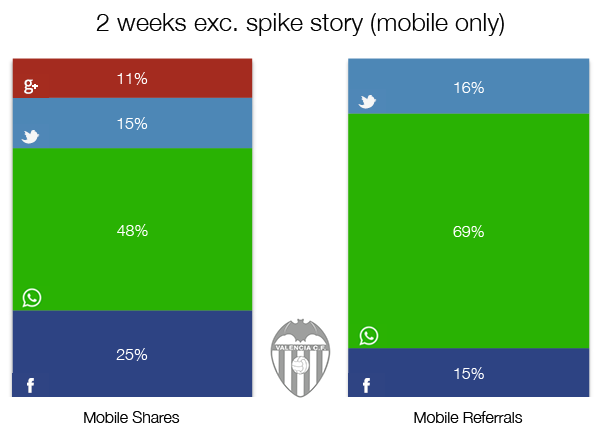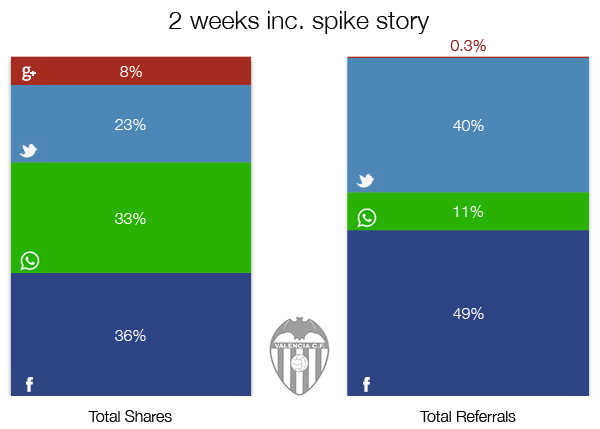
How news sites think about social platforms changes with time.
Five or six years ago, it wasn’t uncommon to see the bottom of a blog post chicken-pocked with a gazillion tiny icons representing social networks familiar and seemingly imaginary. More recently, as Facebook and Twitter have grown, you’ve seen a lot of sites trim that spot down to just those two.
A couple years ago, the leading candidate to join those two would have been Google+, and it still shows up in a lot of places. But the real new contender is the new generation of chat apps, most prominently the acquired-by-Facebook-for-$19-billion WhatsApp. Their primary mode is one-to-one sharing as opposed to Twitter and Facebook’s one-to-many. But they’re such a large and growing part of people’s lives on mobile devices that they demand attention.There’s one thing news outlets have been missing in evaluating apps like WhatsApp: good analytics. There’s not an easy way to tell if that visit to your website a moment ago came from a chat app, because it doesn’t leave a referer. It’s the very definition of dark social. And without numbers, it’s hard to know how much to optimize for WhatsApp traffic. Recode reported back in February that BuzzFeed seemed to be seeing terrific WhatsApp sharing action, but the data was still rough:
In other words, a lot of people were tapping the button, but there wasn’t a good way to tell whether that was turning into substantial traffic.“Every time we looked at WhatsApp’s numbers, it blew us away,” said BuzzFeed president Jon Steinberg. “We knew last April this was a huge social network and have become increasingly obsessed with it.”
BuzzFeed integrated WhatsApp’s share button on iOS in October, and has seen shares double in the last few months, said BuzzFeed VP of business development Ashley McCollum.
But the WhatsApp tool is still very basic. “We only have click data, not referral data,” McCollum said. “So we know if you clicked the share button in mobile Web, but we don’t know (yet) if you shared in on a group text with 15 people and 15 people clicked it or if you shared it with one person.”
That’s why I’m pleased to be able to share with you some actual hard data that looks at both the sharing piece and the traffic piece. It’s from an unusual source: the Spanish soccer club Valencia, currently sitting in third place in La Liga behind more internationally famous clubs Real Madrid and Barcelona.
Valencia, like most sports teams, has its own website where it publishes news stories about the team. And on the mobile version of its news stories, it includes four sharing buttons: Twitter, Facebook, Google+, and WhatsApp. It captures both click data (how many times each of those buttons was tapped) and, crucially, traffic data, by adding a URL parameter that helps them tell which service the reader is coming from.
So armed, Valencia is able to tell what platforms are most important for sharing. Here’s what it found. (This data comes from Daniel Ayers, who works for the sports-focused digital consultancy Seven League and has been serving as Valencia’s acting head of digital.)
What share of users’ clicks or taps did each of the four sharing buttons get? Facebook 35%, WhatsApp 33%, Twitter 19%, and Google+ 13%.
That’s a remarkably good showing for WhatsApp — even more remarkable when you realize that the WhatsApp button doesn’t even appear on desktops or laptops, only on mobile devices. (Technically it appears in any web browser no more than 740 pixels wide, which basically means smartphones.) So what happens if you only look at mobile shares?
You get this: Facebook 25%, WhatsApp 48%, Twitter 15%, and Google+ 11%.
WhatsApp gets nearly half of the sharing taps on mobile.
But what about traffic? Did those taps turn into lots of visits? Let’s go back to the larger dataset, mobile and desktop/laptop combined. What share of the visits did taps on each of those buttons produce? Facebook 27%, WhatsApp 48%, Twitter 22%, Google+ 3%.
In other words, WhatsApp has an even higher share of referers (48%) than it did taps (33%).
And what if we just look at mobile again? This is what you get: Facebook 15%, WhatsApp 69%, Twitter 16%, and Google+ zilch.
That’s crazy. Of those four sharing buttons on mobile, WhatsApp is generating more than two-thirds of the visits for Valencia.


Now, before you go make your news site one giant green WhatsApp button, there are two very important caveats to this data.
The first is national context. User behavior in Spain may not match user behavior in your country. As of earlier this year, 65 percent of Spain’s mobile Internet users were using WhatsApp; the equivalent number in the United States was just 8 percent.
(A sampling of other countries: France 6 percent, Australia 15 percent, Canada 16 percent, U.K. 36 percent, Germany 57 percent, Brazil 59 percent, Mexico 64 percent.)
In other countries, particularly in Asia, other chat apps (Kakao Talk, Line, WeChat) dominate the market. And chat apps haven’t taken off here in the U.S. to the degree they have in the rest of the world, where carrier (SMS) and smartphone-specific (iMessage, BBM) platforms are more popular.
But nonetheless, whether it’s WhatsApp or something else, it’s likely this generation of platforms will keep growing.
The second caveat is when stories blow up big — when they go viral. You may have noticed that in the charts above, the titles say they exclude a “spike story.” That’s because during the period Valencia was examining the data, they had one story really break out: this announcement that the club would subsidize tickets for its supporters who wanted to attend an away match at crosstown rival Levante. As you might imagine, the story blew up, earning more than 1,800 tweets and 12,000 Facebook likes, shares, and comments.
The charts above ignore that story, since it was such an outlier. But if you include it in the data, you get a different picture:


Facebook and Twitter suddenly look a lot more powerful, even on mobile. Why? It’s that gap between one-to-one/few and one-to-many. Most tweets don’t go anywhere — but when one blows up, it can blow up big. As open platforms built around following and friending, Facebook and Twitter enable big stories to get much bigger than private, individual-focused WhatsApp can.
As Valencia’s Ayers put it to me in a couple emails:
In short, WhatsApp outperforms Facebook, Twitter, and G+ for total referrals under “regular” content conditions, i.e. non-viral, non-spike stories. It results in almost 2 referrals per share, compared to 1 or less for the others.
When you do have a big spike article, WhatsApp still performs well for volume of shares, but the greater reach potential of FB and Twitter is activated — those channels start to generate 10 referrals for every share…
I think that for a site with a traffic profile which is heavily skewed towards spike/viral stories (BuzzFeed, or major news publishers), then the overall impact of referrals from WhatsApp will be less, because more of the potential reach of Twitter and Facebook will actually be realised. But, most club/brand sites will have a similar profile to valenciacf.com.
So what should a news site take away from this data?
First, if you’re in a country with high WhatsApp use, you should probably add a little green button to the Facebook/Twitter shades of blue already on your mobile news stories. Spot checking a few major news sites in those countries, it’s remarkable how few have them. Particularly for your users on iPhones, WhatsApp isn’t as seamlessly integrated into the OS as Facebook and Twitter are, so the button could lead to a real shift in behavior.
Second, start gathering data. Put a parameter on your WhatsApp URLs and see what kind of action they generate.
Third, if you’re in a country where a different chat app is dominant, as in Asia, a button might generate a good return for the pixel investment.
And fourth, if you’re in the United States, none of these apps may be big enough yet to justify the design attention — but they’re headed in that direction. And their users are disproportionately young and on mobile devices — markets news organizations are chasing. Do some A/B testing and run your own data, but this might be a trend worth getting ahead of.